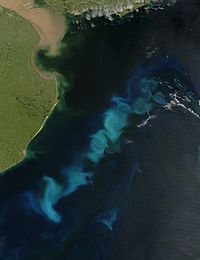
Photo from wikipedia
Abstract A recent study using Fe-limited phytoplankton strains, showed that iron (Fe) uptake rates normalized by cellular surface area were best related to dissolved iron (dFe) concentrations as the inorganic… Click to show full abstract
Abstract A recent study using Fe-limited phytoplankton strains, showed that iron (Fe) uptake rates normalized by cellular surface area were best related to dissolved iron (dFe) concentrations as the inorganic Fe (Fe’) supply rates were not sufficient to satisfy the Fe biological demand. Short-term (24 h) shipboard incubations with the in-situ phytoplankton community were used to measure Fe uptake rates that were normalized per biomass (as particulate organic carbon, POC). Fe uptake rates measured following 55FeCl3 additions (0.05 to 0.9 nM) were fitted to different Fe pools (dFe, Felabile, and Fe’) using the Michaelis-Menten equation. Data showed a similar high conditional stability constant for biological transporters across all sites and phytoplankton size classes, with only a 2-fold variation in the concentrations of cellular transporters. These observations are in line with previous reports that eukaryotic phytoplankton takes up Fe close to the limit imposed by transporters cellular density and uses similar high-affinity Fe uptake systems. To further explore the link between Fe uptake rates and Fe chemistry, we also studied the effect of Fe additions preequilibrated with different Fe-binding ligands (L) including: the siderophore desferrioxamine B, two carbohydrates (glucuronic acid and carrageenan) and two different bacterial exopolycarbohydrates (L6 and L22, referred as EPS). For all stations, phytoplankton were able to acquire Fe associated to DFB as previously reported, however, different Fe:L ratios prevent quantitative comparison with other studies. Iron bound to carbohydrates, glucuronic acid, carrageenan and EPS could enhance or decrease Fe uptake rates in comparison to equimolar FeCl3 addition. These results illustrate that the effect of such L on Fe uptake rates will depend on the in-situ plankton community and their chemical structure. The variation of the Fe’ concentrations was able to explain up to 69% of the Fe uptake rates observed for the Antarctic communities. This relationship with Fe’ was related to the fact that the Fe’ maximal supply, due to the dissociation of FeL, was enough to satisfy the measured Fe uptakes rates. Calculations using previous reports in contrasted regions of the Southern Ocean, showed that Fe’ maximal supply was greater than Fe uptake rates measured in 80% of the cases. Moreover, considering photo- and redox-chemistry as well as kinetical situations prevailing in the field, Fe’ should not be overlooked as a pool able to satisfy most of the Fe biological demand. Finally, this study points towards the potential that the GEOTRACES Fe chemical speciation data represent to explore Fe uptake rates at a larger scale in this vast Fe-limited oceanic region.
Journal Title: Marine Chemistry
Year Published: 2020
Link to full text (if available)
Share on Social Media: Sign Up to like & get
recommendations!